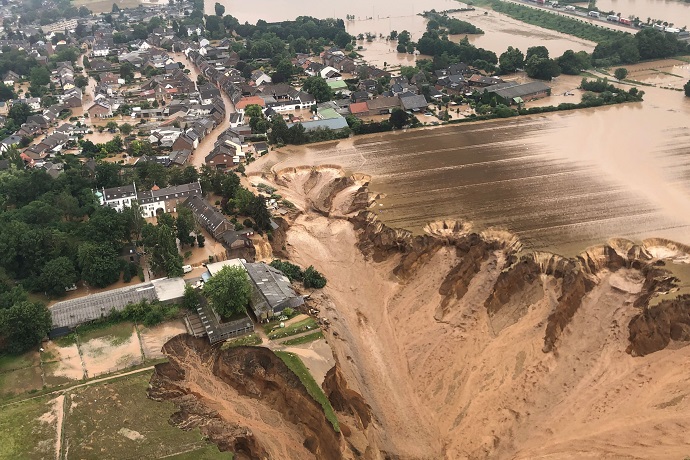

The disastrous flood which hit several European countries in July 2021 illustrates well the importance of EFAS as a critical European tool to forecast flooding events. As the intensity and frequency of severe weather events increases around the world, it is paramount that forecasting skill should continue to improve. (Photo of Erfstadt-Blessem, Germany – credit: Rhein-Erft-Kreis)
ECMWF is to continue as the computational centre for the hydrological forecasting activities of the EU-funded Copernicus Emergency Management Service (CEMS) for a further six years until 2027.
The computational centre helps to deliver the European and Global Flood Awareness Systems, EFAS and GloFAS.
The new framework contract is managed by the Joint Research Centre (JRC) of the European Commission – the entrusted entity responsible for CEMS – and has been awarded to ECMWF for the third time.
Flood awareness systems
The European and Global Flood Awareness Systems EFAS and GloFAS are at the core of the CEMS Early Warning System (CEMS-EWS) Flood component.
EFAS was the first of the CEMS-EWS services, run operationally by ECMWF since 2011 following its development by the JRC. In parallel, GloFAS, co‑developed by ECMWF and the JRC in collaboration with the University of Reading, was run by ECMWF as a prototype service from 2011 and became operational in 2018.
Since then, both systems have provided the European Union's Emergency Response Coordination Centre (ERCC), national hydrological and meteorological services (NHMS) and authorised users with a reliable and robust 24/7 service, including daily overviews on ongoing and predicted major floods in Europe and the world.
EFAS now has over 900 users from 141 institutions, while GloFAS has over 6,000 registered users worldwide.

This EFAS map shows the risks of flooding on 12 June 2021. The red (yellow) squares show river points where flooding within the next 10 days is expected to exceed the 5-year (2-year) return period.
ECMWF’s role
As the CEMS Hydrological Forecast Centre – Computation (COMP), ECMWF is responsible for the operation of the CEMS state-of-the-art hydrological probabilistic forecasting systems, which includes ECMWF ensemble weather forecasts, as a 24/7 service.
It is also in charge of the service evolution, migrating from research to operations new components developed by either ECMWF or other collaborators, such as the JRC. This includes:
- implementing scientific advances to improve hydrological forecast skill (e.g. hydrological modelling, product definition, error diagnostics, and performance improvement);
- continuous system upgrades, such as integrating new observational data and developing user-defined forecast products;
- delivering service improvements, ranging from website design and functionalities to optimised flood notification criteria;
- any development to ensure the timely delivery of products (e.g. system component and processing chain optimisation, continuous integration, software upgrade and maintenance).
ECMWF’s responsibilities include developing, maintaining and hosting EFAS and GloFAS Information Systems and associated web services, in particular delivering tailored tools for the CEMS Hydrological Forecast Centre - Analytics and Dissemination.
ECMWF also integrates in the web platform relevant new products from other CEMS services as required, such as Global Flood Monitoring products, and provides data services, e.g. to other Copernicus Services.
ECMWF engages strongly with the CEMS-EWS for Floods user community. This ranges from being responsible for EFAS and GloFAS user management and service access to providing user support for all EFAS and GloFAS products and services.
Finally, ECMWF contributes to training and outreach activities with other CEMS hydrological forecast centres, by hosting meetings, delivering hydrological bulletins, contributing to the Copernicus Climate Change Service (C3S) State of the Climate reports, and promoting EFAS and GloFAS at relevant conferences and workshops.
In addition to the computational centre, three other operational centres deliver the CEMS-EWS for Floods, with support from the JRC: the CEMS-Flood Data Collection Centres METEO (KISTERS AG and DWD) and HYDRO (Soologic), and the CEMS Hydrological Forecast Centre - Analytics and Dissemination DISS (SMHI, SHMU and Rijkswaterstaat). ECMWF has strong interactions with all of them.
EFAS and GloFAS developments
As operational services, EFAS and GloFAS are always evolving to provide state-of-the-art flood forecasts and web and data services to registered users. A lot has happened in the last few years, with developments expected to continue during the next phase of the service:
- Hydrological forecast improvement. This includes new calibration for EFAS and a new hydrological model for GloFAS delivered in 2020. An increase in the spatial resolution is planned for both. This may also include the implementation of new components, such as improved river routing or development of a data assimilation module in the LISFLOOD model, now used for both EFAS and GloFAS.
- Product evolution. This includes improved flood impact forecast assessments delivered in 2020–2021, but also optimisation of flood notification criteria, or improvement in the flash flood forecasting method.
- Service evolution. This includes access to all hydrological simulations through the C3S Climate Data Store (started in 2019), improved websites and services, enhanced data sharing functionalities, and improved and extended collaboration with and feedback from users.
More information
EFAS and GloFAS have dedicated web interfaces accessible through registration: www.efas.eu and www.globalfloods.eu respectively.
In addition, a CEMS-Floods wiki provides more detailed information on the different service elements.
